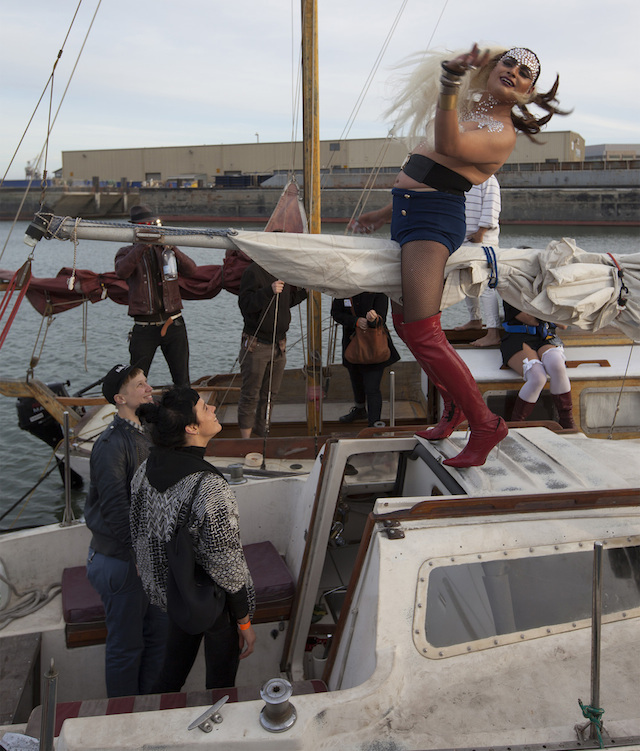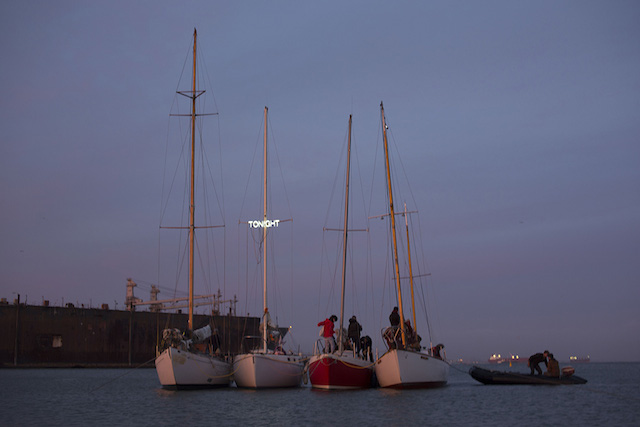
1. Constance Hockaday. From All These Darlings and Now Us, 2014. Selection from project documentation; dimensions variable. Courtesy Southern Exposure, San Francisco. © Constance Hockaday.
In 2009, Theaster Gates purchased the first of several vacant properties that would become the site for Dorchester Projects, on the South Side of Chicago. It was both an act of opportunism hitched to the declining real-estate values amid the Great Recession of the early twenty-first century and an act of reclamation. By applying local labor, materials, and (in the artist’s words) the devices of a community with time on their hands, Gates and his collaborators transformed abandoned buildings on Dorchester Street into community properties that contain publicly accessible amenities, such as the Archive Room, the Listening Library, and a reading room. An artist residency and a film program are soon to follow.
That same year, I was working part-time at a commercial gallery in San Francisco’s Union Square, trying to sell contemporary Asian paintings to wealthy tourists and local collectors. My instructions were simple: discuss the artists’ resumes, emphasize their origins, and recite some key words from art history; engage collectors; don’t waste time talking to the merely curious. I had no idea what I was doing. I was terrible at sales and had lost any meaningful sense of what art is or does. I realized that if I continued pursuing this path, ultimately my service to arts and culture would consist of working for the rich. It was time to switch course.
I applied for an internship at Southern Exposure (SoEx), a San Francisco–based nonprofit that is “continually evolving in response to the needs of artists and the [local] community while engaging the public in artists’ work.”[1] I began working just as the organization was moving from a tiny venue at 14th and Valencia Streets to a cavernous space deeper in the Mission neighborhood, with high ceilings and greater square footage—a curator’s dream. Since then, SoEx’s programming has shifted significantly to focus on event-based community programming and temporary public-art interventions, otherwise referred to as social practice. Today, its Valhalla of an exhibition space is seldom sanctified by the display of rarefied objets d’art.
Social practice is an artistic strategy that uses people as its medium. The efficacy of this strategy raises some very important questions: Who is the instrument, and who controls it? Is authorship the same as accountability? Who provides the means of the work and to what ends is the work done—the artist or the community envisioned through intervention?
These questions came to mind during my first visit to Treasure Island. I was there with with my new husband and some new friends. I had been invited by SoEx to participate in Constance Hockaday’s work, All These Darlings and Now Us (2014), a floating peep show. I use the word participate loosely; we were there to perform the role of voyeur, a lurid synonym for spectator. From a crab shack where we registered our arrival, we hiked to a beach where we were transported by inflatable boats to four other deteriorating sailboats, lassoed together by nautical ropes. My companions were a bit sheepish, but I was enamored of the experience. The performers were cut from Bay Area cloth: trans, queer, all body types, bound, feathered, bedazzled, and chained. Many of them had performed at San Francisco’s Lusty Lady, a unionized and worker-owned peep-show co-op, or Esta Noche, a Latino gay bar, both of which had closed by the time All These Darlings was publicly performed. According to Hockaday’s website, more than six hundred people enjoyed the show: “art people, old guys, queers, sex workers, young professionals, and working-class sailors.”[2] Still, the performers of All These Darlings would have likely earned more in their landlubber establishments, than out at sea.

1. Constance Hockaday. From All These Darlings and Now Us, 2014. Selection from project documentation; dimensions variable. Courtesy Southern Exposure, San Francisco. © Constance Hockaday.
However, the concept of the work was solid. In recent years, the demographics of the Bay Area have shifted. San Francisco has become a destination for lucrative tech industries and thus their young and financially flush talent. That talent has expensive and (relative to the Bay Area) heteronormative tastes. Their money dictates the cultural character of the city. For transgender sex-workers and new-genre artists, audiences and spaces are becoming scarce. The purpose of All These Darlings was to bring attention to a looming real-estate bottle-neck that is displacing a fair and generous trade from San Francisco’s neighborhoods, which form a newly minted monoculture of sanitized hills and boulevards. As expressed by Hockaday’s piece, the only territory left for underground and alternative culture is the water.
Last month, I participated in a Web conference hosted by Grantmakers in the Arts, “The Role of the Artist in a Changing Community: Supporting Artists Working in Other Places.” The conference presenters reflected on the roles of various stakeholders in creative place-making and community development. In one case study, Roseann Weiss, of the Regional Arts Commission of St. Louis, spoke of her work with the Community Arts Training Institute (CAT); this intensive program provides artists, educators, activists, and policy makers with the tools and skill sets to initiate and sustain transformational, community-based arts programming. The key lesson from the conference: Artist-led community collaborations should be designed as invitations, not interventions.
Collaboration should be initiated by local partners seeking creative approaches toward community issues, not exported by visionary artists looking to build their portfolios and a sense of purpose. The success of these projects depends on long-term commitments to achieving outcomes defined by the communities that they aim to serve. Or, put more simply by Theaster Gates in a recent interview: “I’m interested in, ‘What happens when you stay?’”[3]
Traditional roles of public art were to commemorate, canonize, promote, and beautify. The disciplines of social practice and new genres have liberated art from solely the making of objects and reframed it as a force, a catalytic process born between the artist and the audience, the community. Conceived to produce ends as well as means, social practice presents a strong strategy around which to organize human will.
—
[1] “Mission,” Southern Exposure, https://www.soex.org/about/mission.
[2] “All These Darlings and Now Us,” Constance Hockaday, https://www.constancehockaday.com/neue-berlin/.
[3] Tim Adams, “Chicago Artist Theaster Gates: I’m Hoping Swiss Bankers Will Bail Out My Flooded South Side Bank in the Name of Art,” Guardian, May 3, 2015, https://www.theguardian.com/artanddesign/2015/may/03/theaster-gates-artist-chicago-dorchester-projects.



